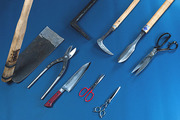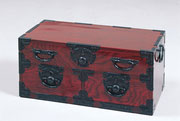Iwate and more
- Sort by
- Popularity
- Name
-
Nambu ironware Nambu tekki
- Metal works
- Iwate

Nambu Ironware (called Nambu tekki in Japanese) is a form of metalwork produced in Morioka City and Mizusawa, Oshu City in Iwate prefecture. It is a traditional craft that was first created in the middle of the Edo period (1603-1868). The name �…
View more
-
Kumano brushes Kumano fude
- Writing tools
- Hiroshima

Kumano brushes (called Kumano fude in Japanese) are traditional craftworks produced in the city of Kumano in Hiroshima prefecture, hence the name. They are made from a wide variety of hair including goat, horse, deer, Japanese raccoon dog, weasel,…
View more
-
Iwayado traditional chest Iwayado tansu
- Wood, bamboo crafts
- Iwate

Iwayado tansu is a traditional woodwork made in the cities of Oshu and Morioka, Iwate prefecture. Tansu means chest of drawers. In addition to clothing or organization chests, daily use items like tea cabinets, book shelves, and low tables are mad…
View more
-
Kaba cherrybark woodcrafts Kaba zaiku
- Wood, bamboo crafts
- Akita

Kaba cherrybark woodcrafts (called Kaba zaiku in Japanese) are a type of wood bark craft produced in the former town of Kakunodate, Akita prefecture. While the character for kaba means birch, for this context the word refers to the bark of wild ch…
View more
-
Odate bentwood Odate mage wappa
- Wood, bamboo crafts
- Akita

Odate mage-wappa is a bentwood craft produced all over the city of Odate, Akita prefecture. This craft is well-known both domestically and abroad for having a beautiful curved shape and being lightweight. The key feature of Odate bentwood is the b…
View more
-
Chichibu-meisen silk Chichibu meisen
- Woven textiles
- Saitama

Chichibu-meisen silk is a textile produced in the city of Chichibu, Saitama prefecture. It is a plain-woven textile with both sides dyed equally because the threads will be stencil dyed. Since the textile is double-sided, it can be washed and rema…
View more
-
Kawatsura lacquerware Kawatsura shikki
- Lacquerware
- Akita

Kawatsura lacquerware (called Kawatsura shikki in Japanese) is produced in the town of Kawatsura in the southern part of Akita prefecture. Everyday use items like bowls and trays have been produced here for a long time. Kawatsura lacquerware has e…
View more
-
Joboji lacquerware Joboji nuri
- Lacquerware
- Iwate

Joboji lacquerware (called Joboji nuri in Japanese) is produced in the town of Joboji in Iwate prefecture. More than 98% of the lacquer used in Japan is imported from China or other countries. The Joboji area is known as the leading producer of do…
View more
-
Ogatsu inkstone Ogatsu suzuri
- Writing tools
- Miyagi

Ogatsu inkstone (called Ogatsu suzuri in Japanese) is a craft produced in the former town of Ogatsu (now city of Ishinomaki), Miyagi prefecture, where artisans still carefully hand carve and polish every piece. What is unique to Ogatsu inkstone i…
View more
-
Boshu uchiwa fans Boshu uchiwa
- Other crafts
- Chiba

Boshu uchiwa is a type of fan made in the areas around the cities of Tateyama and Minamiboso in Chiba prefecture. This is one of Japan’s big three uchiwa types, with the other two being Marugame (Kagawa prefecture) and Kyo uchiwa (Kyoto prefecture…
View more
-
Hidehira lacquerware Hidehira nuri
- Lacquerware
- Iwate

Hidehira lacquerware (called Hidehira-nuri in Japanese) is produced in the area around the town of Hiraizumi, in Iwate prefecture. The defining feature of Hidehira lacquerware is the use of gold leaf produced in the area around Hiraizumi, which re…
View more
-
Iwatsuki doll Iwatsuki ningyo
- Dolls, kokeshi
- Saitama

Iwatsuki doll (called Iwatsuki ningyo in Japanese) is a type of doll made in Iwatsuki ward, Saitama prefecture. This doll is known for its round face with big eyes, smooth and beautiful skin, and shiny human-like hair. The white skin comes from a …
View more
-
Inshu traditional Japanese paper Inshu washi
- Traditional Japanese paper
- Tottori

Inshu washi is a handmade traditional Japanese paper made in the former Inaba province, the eastern part of Tottori prefecture. The most famous type of paper is a textured drawing paper that is ideal for calligraphy and ink painting, boasting high…
View more
-
Yumihama traditional resist-dyed textiles Yumihama gasuri
- Woven textiles
- Tottori

Yumihama traditional resist-dyed textiles (called Yumihama gasuri in Japanese) is produced near the city of Sakaiminato, Tottori prefecture. The name comes from Yumigahama, which is a curved shore that stretches for more than twenty kilometers (ab…
View more
-
Naruko lacquerware Naruko shikki
- Lacquerware
- Miyagi

Naruko lacquerware (called Naruko shikki in Japanese) is a form of lacquerware produced around the city of Osaki, Miyagi prefecture. Lacquerware is a craft coating layers of lacquer on wooden tableware and other utensils. Lacquerware is produced i…
View more
-
Miyagi kokeshi doll Miyagi dento kokeshi
- Dolls, kokeshi
- Miyagi

Miyagi Kokeshi Dolls (called Miyagi Dento Kokeshi in Japanese) are wooden dolls produced in and around the cities of Sendai and Shiraishi, Miyagi prefecture. Categorized based on region into five styles including Naruko kokeshi and Togatta kokeshi…
View more
-
Fukuyama Koto (Japanese Harp) Fukuyama koto
- Other crafts
- Hiroshima

Fukuyama koto is a Japanese harp, koto, produced in Fukuyama, Hiroshima prefecture. Most of the koto produced in Japan are made in Fukuyama, which is where the coastal view of the city inspired one of the most well-known koto songs, Haru no Umi (S…
View more
-
Miyajima woodwork Miyajima zaiku
- Wood, bamboo crafts
- Hiroshima

Miyajima Woodwork (called Miyajima zaiku in Japanese) are woodwork products made in Miyajima, Hatsukaichi, Hiroshima prefecture. Miyajima Island, one of the Three Views of Japan*, has long been nicknamed the "Island of Gods", while Hatsu…
View more
-
Edo-kimekomi doll Edo kimekomi ningyo
- Dolls, kokeshi
- Saitama

Edo Kimekomi Dolls (called Edo Kimekomi ningyo in Japanese) are mainly produced in Taito, Sumida, and Arakawa wards which are located in northeastern Tokyo. The doll’s body, arms, and legs are made of toso, a modeling material made of paulownia sa…
View more
-
Hiroshima Buddhist altar Hiroshima butsudan
- Household Buddhist altars
- Hiroshima

Hiroshima Butsudan are golden Buddhist altars mainly produced in Hiroshima City, Hiroshima Prefecture. The Buddhist sect, Jodo Shinshu has been widely worshipped in Hiroshima since ancient times, and many golden altars recommended by the sect were…
View more
-
Kawajiri brushes Kawajiri fude
- Writing tools
- Hiroshima

Kawajiri Brushes, called Kawajiri Fude in Japanese are mainly used for calligraphy and they are produced in the town of Kawajiri in the east of the city of Kure, Hiroshima prefecture. This town, lying at the foot of Mt. Noro and fronting onto the …
View more
-
Kasukabe traditional paulownia chest Kasukabe kiri tansu
- Wood, bamboo crafts
- Saitama

Kasukabe traditional paulownia chests, called Kasukabe Kiri-tansu in Japanese, are traditional woodwork made around Saitama City and Kasukabe City, Saitama Prefecture. Kasukabe Kiri-tansu are distinguished by their simple design based on the strai…
View more
-
Akita cedar tubs and barrels Akita sugi oke taru
- Wood, bamboo crafts
- Akita

Akita-sugi Oke Taru are handmade Akita cedar tubs and barrels produced from locally grown cedar timber in the cities of Odate and Noshiro of Akita Prefecture since around the late Heian period (11th century). Products made of straight grain wood w…
View more
-
Chiba Artisan Tools Chiba Koshogu
- Metal works
- Chiba

Chiba Artisan Tools are cutlery and hand tools made in the Boso Peninsula of Chiba prefecture, using traditional techniques. Their main products are sickles, hoes, knives and western style scissors. As iron sand was mined in the Boso Peninsula fr…
View more
-
Gyoda Tabi Socks Gyoda tabi
- Other textiles
- Saitama

Gyoda Tabi Socks, known as Gyoda Tabi in Japanese, are produced in Gyoda, Saitama Prefecture, which is the largest production center of tabi socks in Japan. Gyoda is surrounded by two large rivers, Tonegawa River and Arakawa River, and has an abun…
View more
-
Sendai traditional chest Sendai tansu
- Wood, bamboo crafts
- Miyagi

Sendai tansu is a type of chest of drawers made in the city of Sendai, Miyagi prefecture. Usually they are made of Japanese chestnut, cedar, and zelkova wood, and renowned for their highly ornamented iron fittings and three different types of beau…
View more
- 1































































































































































































































































































